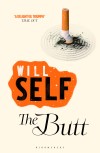Interesting little interview with Will in Brazil. And there is a second part too.
I’m not fooled by Purnell’s new welfare conjuring trick
Will’s latest Standard column can be read here.
22.07.08
The Butt
Synopsis:
Tom Brodzinski is a man who takes his own good intentions for granted. But when he finally decides to give up smoking, a moment’s inattention to detail becomes his undoing. Flipping the butt of his final cigarette off the balcony of the holiday apartment he’s renting with his family, Tom is appalled when it lands on the head of one his fellow countrymen, Reggie Lincoln. The elderly Lincoln is badly burnt, and since the cigarette butt passed through public space before hitting him, the local authorities are obliged to regard Tom’s action as an assault, despite his benign intentions. Worse is to follow: Lincoln is married to a native from one of the rigorous, mystical tribes of the desert interior, and their customary law is incorporated into the civil statute.In order to make reparations to Mrs Lincoln’s people, Tom will have to leave his family behind, and carry the appropriate goods and chattels deep into the arid heart of this strange, island continent. Any of this might be bearable, were it not for Tom’s companion, forced on him by his enigmatic lawyer, the mixed-race Jethro Swai-Phillips.
Brian Prentice, like Tom, has to make reparations and although there is a taboo that prevents either man from knowing the exact detail of the other’s offence, Tom’s almost 100 per cent certain that he’s a child-abuser. As they drive into the desert and encounter a violent counter-insurgency war that Tom has allowed himself to remain in ignorance of, the relationship between the two men becomes one of complicit guilt as well as seething mistrust. Refusing facile moral certitudes, Will Self’s latest novel is set in a distorted world, in a country that is part Australia, part Iraq, part Greeneland and part the heart of a distinctively modern darkness.
Psychogeography

Psychogeography – Will Self
![]()
![]()
See all books by Will Self at
Amazon.co.uk | Amazon.com
Synopsis:
Provocateurs Will Self and Ralph Steadman join forces in this post millennial meditation on the vexed relationship between psyche and place in a globalised world, bringing together for the first time the very best of their “Psychogeography” columns for the “Independent”. The introduction, ‘Walking to New York’, is both a prelude to the verbal and visual essays that make up this extraordinary collaboration, and a revealing exploration of the split in Self’s Jewish American British psyche and its relationship to the political geography of the post 9/11 world. Ranging from the Scottish Highlands to Istanbul and from Morocco to Ohio, Will Self’s engaging and disturbing vision is perfectly counter pointed by Ralph Steadman’s edgy and beautiful artwork.
Banksy lost his street cred the moment he found fame
There’s been no confirmation yet but it looks as if the reclusive graffiti artist Banksy may have had his real identity revealed as 34-year-old ex-public schoolboy Robin Gunningham. You can understand why he went for nom-de-spraycan, if indeed Gunningham is the person responsible for all those subtly subversive images: the rats wielding rocket-propelled grenades along the Embankment, and the legend Do Not Paint Over This Graffiti by the Albert Bridge, to name but two.
But as to the supposed “revelation” that Banksy is far from being a man of the people — can that be any real surprise? Many of the great subversive artists of the 20th century, working when the avant garde really meant something, were from middle-class and even patrician backgrounds. Frankly, you often need a little in the way of financial cushioning to risk real nonconformity.
Not that I think Banksy ever was truly avant-garde; or rather, such credentials as he had were soon mortgaged as he acquired a certain notoriety. To begin with, graffiti art is a field full of anguished young men desperate for some kind of recognition. The archetypal graffiti artist isn’t Banksy but the obsessive-compulsive Enzo, who has marked an estimated 250,000 train windows with his simplistic tag.
As soon as “Banksy” became an identifiable artist — and particularly when his work began to appear in book form and be exhibited in galleries – he ceased to have any street cred at all, no matter that he still hung on to his anonymity. By the time his work began being collected by the likes of — gulp! — Brangelina, he was about as “street” as a Tory transport spokesman.
But anyway, having street cred isn’t the same as being avant-garde; rather, it’s the search by the jaded mainstream for some exciting and new primitivism. To be avant-garde — as the term suggests — is to be out in front of mainstream artists, creating work that through its sheer daring and brio increases the ambit of what may be possible.
Throughout the 20th century, truly avant-garde artists, writers and filmmakers fought a stiff battle against the forces of conformity: their aim was to make it possible to write and paint and make films about previously taboo subjects, principally sex and religion. They succeeded more than they ever could have believed possible, helping to make a culture in which it is now possible for us to experience the most extreme of mediatised experiences, scant few of which are genuinely art.
That has been one downside of the triumph — and subsequent death — of the avant-garde. The other is that while it’s possible nowadays to say anything, nobody much is listening any more. Or rather, they’re listening to whichever wannabe — such as Banksy — the media have seized on to.
15.07.08
Postcard from Cognac
To read Will’s latest Psychogeography column, click here.
12.07.08
Best foot forward
For years now pressure groups such as Living Streets and the Ramblers Association have been urging the Government to produce a co-ordinated national walking strategy. With almost geological slowness a “discussion paper” has been circulated, limping from not very interested party to indifferent one. In the meantime, local authorities have pushed ahead with their own walking strategies. If you feed these words into Google you’ll come up with plans advanced by councils as various as Luton and Cheshire. Reading them is to stroll into a petrified forest of bureaucratic jargon, where a Sits (Sustainable Integrated Transport Strategy) sits on the rotten boughs of verbiage.
Meanwhile, the situation gets worse and worse: between the mid-1980s and 1990s walking declined as a proportion of journeys undertaken from 34 per cent to 27 per cent. Assuming — and I see no reason not to — a similar decline for the past decade, we have only one in five journeys being made on foot. It’s just as well that native habitats are declining and woodland being grubbed up, because on current projections no one will walk anywhere at all within 30 years.
Already the evolutionary consequences of our lack of ambulation are being seen: concrete evidence that the theories of Lamarck, for so long discredited, do indeed accurately describe the mechanisms of heritability. Three years ago in Stoke-on-Trent a child was born who, while perfectly healthy in every other respect, had a completely globular body covered with an epidermal layer of dense latex. “Roland X” — as the child is known — is now attending nursery school, and makes the half-mile journey there by car, after being “bounced into the back seat of the family Jeep” by his mother.
Roland is not the only sport: in Peebles there are now five-year-old twins who instead of feet have sets of double bogies curiously reminiscent of those found on shopping trolleys. The obstetrician who delivered them, Dr Finlay Quaye, told The Herald: “They’re in all respects happy, normal children, although they find it difficult to avoid being pushed about a bit in the playground.”
The apparently “natural” occurrence of wheeled or ball-shaped human beings has led to a disturbing new fad in radical elective surgery. Adults are having their feet and legs amputated and replaced with a variety of wheeled prosthetics, ranging from in-line skates to powered scooters. Hermione Forster of the Disability Alliance has described these people as “sadly deluded concerning the consequences of abandoning bipedalism. Once they discover just how parlous the facilities are for wheelchair access they often want to change back — but by then it’s too late.” Then there’s the Weil’s Disease epidemic raging in the Fens, as more and more teenagers have their legs sewn together and take to the waterways, rather than put up with the unutterable tedium of putting one foot in front of the other.
Obviously it’s high time the Government acted on this, and I’m pleased to see that they have: this year a communique was issued by the Department of Culture, Media and Sport pledging that by 2012 every man, woman and child in Britain will have been encouraged to increase the amount they walk by the staggering total of 1,000 paces per year. Moreover, walking is being trumpeted as one of the key legacies of London’s 2012 Olympic games, with a colossal £7m earmarked for encouraging people to put one foot in front of the other — that’s 12p for everyone!
Tessa Jowell has said: “It is no longer enough that we be seen to walk the walk, we must talk up the walk even if this requires cutting corns. We will be creating a new brand mark of excellence — the first in the world for pedestrians — to be called ‘The Golden Foot’. Walkways, paths, trails, woods, fields and even roads can all apply to display the Golden Foot together with jaunty stickers saying ‘I’m a Toe-Sucker’. The campaign will be launched by the Duchess of York at a mass rally in Birmingham city centre at which thousands of former couch potatoes will symbolically stamp to pieces their TV remotes. A new long-distance path, running 1,000 paces from Parliament to Downing Street will be opened by the greatest living human being, Nelson Mandela, and in his honour will be named ‘The Long March to Freedom’. Anyone who undertakes the path will be rewarded with a statue of Nelson Mandela in their home town.”
Stirring stuff, I think you’ll agree, but we’ve seen it all before: the grand vision, the will to change, the huge spend — and then it all ambles into the ground. No, I think that if the Government wants to get more people walking they’d be far better advised to deal with the real impediments: the snakes in the grass, the dodgy paving stones, disused mineshafts and chronic laziness.
To see Raph Steadman’s art work, go here
05.07.08
Mokni rebel
Read Will in the Guardian, writing about what he thinks of texting, a bit about the text speak in The Book of Dave and how he doesn’t want to be “imprisoned by Lynne’s Truss”.
05.07.08
If you want to beat fuel prices …
Read Will’s latest Standard column here.
08.07.08
Will reading from Dorian
The literary salon Polari will be hosting a free evening next Tuesday, July 8, from 7pm at the Green Carnation, 4-5 Greek Street, London W1, where Will is going to read from and talk about his novel Dorian.
- « Previous Page
- 1
- …
- 119
- 120
- 121
- 122
- 123
- …
- 145
- Next Page »

